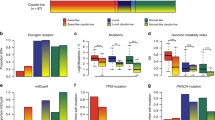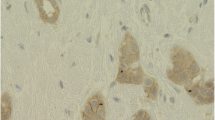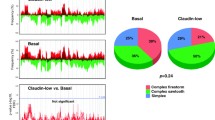Abstract
In the present study we investigated the protein expression of claudins 1, 3, and 4 and their relationship to clinical variables and outcome in a cohort of ER−ve and ER+ve human invasive breast cancers. Immunohistochemical analysis was performed on tissue microarrays representing a total of 412 tumors and interpretable data was derived from 314, 299, and 306 tumors for claudins 1, 3, and 4, respectively. In the ER+ve subset, 5%, 89%, and 52%, and in the ER−ve subset, 39%, 79%, and 79% of tumors stained positively for claudins 1, 3, and 4, respectively (p < 0.0001, p = 0.026, p < 0.0001). Thus, in the two subsets, a significantly higher number of tumors were positive for claudins 3 and 4, compared to claudin 1. In addition, protein expressions of claudins 1 and 4 were significantly higher in those tumors that displayed characteristics of the basal-like subtype of breast cancers (ER−ve, Her-2−ve, EGFR+ve, CK5/6+ve). This study shows a unique pattern of expression for the different claudins in ER−ve and ER+ve tumors. Our data also suggests that increased expression of claudins 1 and 4 was associated with the basal-like subtype of breast cancers, a subtype generally linked to poor outcome.



Similar content being viewed by others
Abbreviations
- EGFR:
-
Epithelial derived growth factor receptor
- EMT:
-
Epithelial mesenchymal transition
- ER:
-
Estrogen receptor
- IHC:
-
Immunohistochemistry
- LBA:
-
Ligand-binding assay
- OS:
-
Overall survival
- RFS:
-
Relapse-free survival
- TMA:
-
Tissue microarray
References
Anderson JM, Balda MS, Fanning AS (1993) The structure and regulation of tight junctions. Curr Opin Cell Biol 5:772–778
Diamond JM (1977) Twenty-first Bowditch lecture. The epithelial junction: bridge, gate, and fence. Physiologist 20:10–18
Tsukita S, Furuse M (2002) Claudin-based barrier in simple and stratified cellular sheets. Curr Opin Cell Biol 14:531–536
Mitic LL, Anderson JM (1998) Molecular architecture of tight junctions. Annu Rev Physiol 60:121–142
Gonzales-Mariscal L. Tight Junctions. [2nd ed.]. 1-1-0001. Boca Raton, CRC
Morin PJ (2005) Claudin proteins in human cancer: promising new targets for diagnosis and therapy. Cancer Res 65:9603–9606
Tobioka H, Isomura H, Kokai Y et al (2004) Occludin expression decreases with the progression of human endometrial carcinoma. Hum Pathol 35:159–164
Kaihara T, Kawamata H, Imura J et al (2003) Redifferentiation and ZO-1 reexpression in liver-metastasized colorectal cancer: possible association with epidermal growth factor receptor-induced tyrosine phosphorylation of ZO-1. Cancer Sci 94:166–172
Blanchard A, Shiu R, Booth S et al (2007) Gene expression profiling of early involuting mammary gland reveals novel genes potentially relevant to human breast cancer. Front Biosci 12:2221–2232
Blanchard AA, Watson PH, Shiu RP et al (2006) Differential expression of claudin 1, 3, and 4 during normal mammary gland development in the mouse. DNA Cell Biol 25:79–86
Hewitt KJ, Agarwal R, Morin PJ (2006) The claudin gene family: expression in normal and neoplastic tissues. BMC Cancer 6:186
Kominsky SL, Argani P, Korz D et al (2003) Loss of the tight junction protein claudin-7 correlates with histological grade in both ductal carcinoma in situ and invasive ductal carcinoma of the breast. Oncogene 22:2021–2033
Tokes AM, Kulka J, Paku S et al (2005) Claudin-1, -3 and -4 proteins and mRNA expression in benign and malignant breast lesions: a research study. Breast Cancer Res 7:R296–R305
Swisshelm K, Macek R, Kubbies M (2005) Role of claudins in tumorigenesis. Adv Drug Deliv Rev 57:919–928
Morohashi S, Kusumi T, Sato F et al (2007) Decreased expression of claudin-1 correlates with recurrence status in breast cancer. Int J Mol Med 20:139–143
Hoevel T, Macek R, Swisshelm K et al (2004) Reexpression of the TJ protein CLDN1 induces apoptosis in breast tumor spheroids. Int J Cancer 108:374–383
Arabzadeh A, Troy TC, Turksen K (2007) Changes in the distribution pattern of Claudin tight junction proteins during the progression of mouse skin tumorigenesis. BMC Cancer 7:196
Soini Y (2005) Expression of claudins 1, 2, 3, 4, 5 and 7 in various types of tumours. Histopathology 46:551–560
Watson PH, Snell L, Parisien M (1996) The NCIC-Manitoba Breast Tumor Bank: a resource for applied cancer research. CMAJ 155:281–283
Skliris GP, Leygue E, Curtis-Snell L et al (2006) Expression of oestrogen receptor-beta in oestrogen receptor-alpha negative human breast tumours. Br J Cancer 95:616–626
Skliris GP, Hube F, Gheorghiu I et al (2008) Expression of small breast epithelial mucin (SBEM) protein in tissue microarrays (TMAs) of primary invasive breast cancers. Histopathology 52:355–369
Takala H, Saarnio J, Wiik H et al (2007) Claudins 1, 3, 4, 5 and 7 in esophageal cancer: loss of claudin 3 and 4 expression is associated with metastatic behavior. APMIS 115:838–847
Emberley ED, Niu Y, Njue C et al (2003) Psoriasin (S100A7) expression is associated with poor outcome in estrogen receptor-negative invasive breast cancer. Clin Cancer Res 9:2627–2631
Nielsen TO, Hsu FD, Jensen K et al (2004) Immunohistochemical and clinical characterization of the basal-like subtype of invasive breast carcinoma. Clin Cancer Res 10:5367–5374
Camp RL, Charette LA, Rimm DL (2000) Validation of tissue microarray technology in breast carcinoma. Lab Invest 80:1943–1949
Gillett CE, Springall RJ, Barnes DM et al (2000) Multiple tissue core arrays in histopathology research: a validation study. J Pathol 192:549–553
Rimm DL, Camp RL, Charette LA et al (2001) Amplification of tissue by construction of tissue microarrays. Exp Mol Pathol 70:255–264
Mucci NR, Akdas G, Manely S et al (2000) Neuroendocrine expression in metastatic prostate cancer: evaluation of high throughput tissue microarrays to detect heterogeneous protein expression. Hum Pathol 31:406–414
Rosen DG, Huang X, Deavers MT (2004) Validation of tissue microarray technology in ovarian carcinoma. Mod Pathol 17:790–797
Chetty R, Jain D, Serra S (2008) p120 catenin reduction and cytoplasmic relocalization leads to dysregulation of E-cadherin in solid pseudopapillary tumors of the pancreas. Am J Clin Pathol 130:71–76
Kim MJ, Jang SJ, Yu E (2008) Loss of E-cadherin and cytoplasmic-nuclear expression of beta-catenin are the most useful immunoprofiles in the diagnosis of solid-pseudopapillary neoplasm of the pancreas. Hum Pathol 39:251–258
Schmeiser K, Grand RJ (1999) The fate of E- and P-cadherin during the early stages of apoptosis. Cell Death Differ 6:377–386
Zhang K, Yao HP, Wang MH (2008) Activation of RON differentially regulates claudin expression and localization: role of claudin-1 in RON-mediated epithelial cell motility. Carcinogenesis 29:552–559
Tay PN, Lan Y, Leung CH et al (2008) Genes associated with metastasis and epithelial-mesenchymal transition (EMT)-like phenotype in human colon cancer cells. Palladin in colon cancer metastasis, AACR
Chan WY, Soloviev MM, Ciruela F et al (2001) Molecular determinants of metabotropic glutamate receptor 1B trafficking. Mol Cell Neurosci 2001(17):577–588
Stamm S, Ben-Ari S, Rafalska I et al (2005) Function of alternative splicing. Gene 344:1–20
Putti TC, El-Rehim DM, Rakha EA et al (2005) Estrogen receptor-negative breast carcinomas: a review of morphology and immunophenotypical analysis. Mod Pathol 18:26–35
Guarino M, Rubino B, Ballabio G (2007) The role of epithelial-mesenchymal transition in cancer pathology. Pathology 39:305–318
Heimann R, Lan F, McBride R, Hellman S et al (2000) Separating favorable from unfavorable prognostic markers in breast cancer: the role of E-cadherin. Cancer Res 60:298–304
Mendelsohn J, Baselga J (2000) The EGF receptor family as targets for cancer therapy. Oncogene 2000(19):6550–6565
bd El-Rehim DM, Ball G, Pinder SE et al (2005) High-throughput protein expression analysis using tissue microarray technology of a large well-characterised series identifies biologically distinct classes of breast cancer confirming recent cDNA expression analyses. Int J Cancer 116:340–350
Jones C, Ford E, Gillett C et al (2004) Molecular cytogenetic identification of subgroups of grade III invasive ductal breast carcinomas with different clinical outcomes. Clin Cancer Res 10:5988–5997
Kulka J, Szasz AM, Nemeth Z et al (2008) Expression of Tight Junction Protein Claudin-4 in Basal-Like Breast Carcinomas. Pathol Oncol Res
Herschkowitz JI, Simin K, Weigman VJ et al (2007) Identification of conserved gene expression features between murine mammary carcinoma models and human breast tumors. Genome Biol 8:R76
Dhawan P, Singh AB, Deane NG et al (2005) Claudin-1 regulates cellular transformation and metastatic behavior in colon cancer. J Clin Invest 115:1765–1776
Sobel G, Paska C, Szabo I et al (2005) Increased expression of claudins in cervical squamous intraepithelial neoplasia and invasive carcinoma. Hum Pathol 36:162–169
Nicholson RI, Johnston SR (2005) Endocrine therapy—current benefits and limitations. Breast Cancer Res Treat 93(Suppl 1):S3–S10
Acknowledgements
The authors would like to thank the personnel at the MBTB for technical support. GPS was funded by a Postdoctoral Fellowship from the Manitoba Health Research Council (MHRC) and previously from the CancerCare Manitoba Foundation (CCMF). TLY was formerly funded by a Manitoba Graduate Scholarship, and is currently funded by a Manitoba Health Research Council Studentship. YM is a Manitoba Medical Service Foundation Career Awardee. This study was supported by a grant from the Health Sciences Research Foundation. Biostatistical consultation was kindly provided by M. Cheang, Sr. Systems Analyst, Department of Community Health Sciences, Faculty of Medicine, University of Manitoba.
Conflicts of interest
The authors have no known conflicts of interests either financial or personal between themselves and others that might bias the work.
Author information
Authors and Affiliations
Corresponding author
Rights and permissions
About this article
Cite this article
Blanchard, A.A., Skliris, G.P., Watson, P.H. et al. Claudins 1, 3, and 4 protein expression in ER negative breast cancer correlates with markers of the basal phenotype. Virchows Arch 454, 647–656 (2009). https://doi.org/10.1007/s00428-009-0770-6
Received:
Revised:
Accepted:
Published:
Issue Date:
DOI: https://doi.org/10.1007/s00428-009-0770-6




